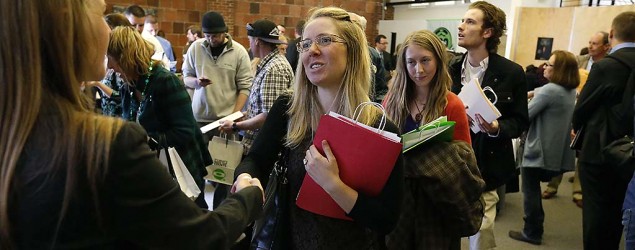
U.S. job growth increased at its fastest pace in more than two years in April, suggesting a sharp rebound in economic activity early in the second quarter.
Nonfarm
payrolls surged 288,000 last month, the Labor Department said on
Friday. That was the largest gain since January 2012 and beat Wall
Street's expectations for an increase of 210,000. March and February
data were revised to show 36,000 more jobs than previously reported.
"The
economy really has strong underlying fundamentals supporting its
growth. Temporary headwinds such as the bad weather can be certainly
managed," said Russell Price, senior economist at Ameriprise Financial
in Troy, Michigan.
Still, the report did give some worrisome signals on the economy's health.
While
the unemployment rate dived 0.4 percentage point to a 5-1/2 year low of
6.3 percent, part of the decline was because hundreds of thousands of
people left the labor force.
Overall,
however, the data suggested the economy was gathering strength and led
investors to pull forward their bets on when the Federal Reserve will
raise interest rates.
U.S.
Treasury debt yields soared after the report, while the dollar jumped to
session highs against the euro and the yen. U.S. stock prices rose
marginally.
Bets on U.S. short-term interest
rates suggested Wall Street is now pricing in a Fed rate hike in June
2015, based on CME FedWatch, which tracks rate hike expectations using
its Fed funds futures contracts. Before the jobs data was released, the
Fed was seen raising rates in July of that year.
The
employment report joins other upbeat data such as consumer spending and
industrial production in suggesting that sputtering growth in the first
quarter was an aberration, weighed down by an unusually cold and
disruptive winter.
The Fed on
Wednesday shrugged off the dismal first quarter performance. The U.S.
central bank, which announced further reductions to the amount of money
it is pumping into the economy through monthly bond purchases, said
indications were that "growth in economic activity has picked up
recently."
Economists expect second-quarter growth to top a 3 percent pace.
HOUSEHOLD SURVEY MIXED
While
details of the bigger survey of employers were robust, the smaller and
volatile household survey from which the unemployment rate is calculated
was mixed, with household employment falling slightly.
The labor force also declined by 806,000 people.
"That is gargantuan decline," said Tom Porcelli, an economist at RBC Capital Markets in New York.
The
labor force participation rate, or the share of working-age Americans
who are employed and unemployed but looking for a job, fell 0.4
percentage point to 62.8 percent. That was the lowest level since last
December.
Some of the 1.35
million people who lost their longer-term unemployment benefits at the
end of last December may have dropped out of the labor force last month.
But
a broad measure of unemployment, which includes people who want to work
but have stopped looking and those working only part time but who want
more work, fell to a 20-year low of 12.3 percent in April. It was at
12.7 percent in March.
Employment
gains in April were broad-based, with the private sector adding 273,000
jobs and government payrolls rising 15,000. Manufacturing employment
increased 12,000 after rising by 7,000 in March.
Construction
payrolls gained 32,000. That followed an increase of 17,000 jobs in
March. The hiring trend could slow in the months ahead as residential
construction loses some steam.Average hourly earnings were flat in April. The length of the workweek held steady at 34.5 hours last month after bouncing back in March from its winter-depressed levels.
Follow Me On WWW.TWITTER.COM/CRISAIGBE


